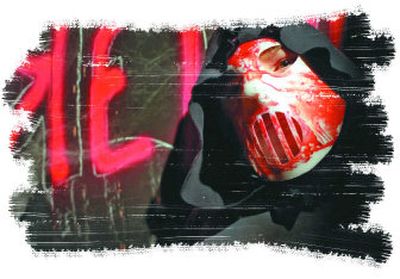Easy on the horror

With the Halloween season under way, mental health advocates have a simple request:
Scare people with ghouls and goblins. Fill your haunted house with trapdoors and tombstones. But leave out the “psychiatric wards,” the “insane asylums” and the bloodthirsty killers in straitjackets.
Such themes, which have become as much a part of Halloween as pumpkins, reinforce negative stereotypes and a stigma that discourages people from seeking treatment, say activists who wage a yearly fight to remove the images from holiday events.
“It’s our annual Halloween horror cycle,” said Bob Carolla, spokesman for the National Alliance on Mental Illness, or NAMI. “The cases vary by size and level of offensiveness, but for some reason, this year has been worse than most.”
Word of about 10 particularly egregious attractions had reached the Arlington, Va.-based organization by halfway through October.
The group’s protests have had some effect. The Wheaton, Ill., Jaycees scrambled to change the theme of their haunted house from “Insanitarium” to something more generic. They retooled an “electroshock therapy” scene into an electric chair; posters and ads touting the theme were quickly pulled; apologies were issued.
Others have not been as receptive, including organizers of an asylum-theme house in Murfreesboro, Tenn., and Paramount’s Kings Island, a popular amusement park outside Cincinnati that is touting its “PsychoPath” – an outdoor trail of fright.
In Provo, Utah, a newspaper recently ran an impassioned editorial to “Bring Back Haunted Castle,” a seasonal fixture at a state hospital that used actual patients as performers before being shuttered almost a decade ago.
“A far more evil force cast the monsters out – political correctness,” wrote the Daily Herald, noting that proceeds benefited the patients’ recreation fund.
Most readers who responded were in favor of resurrecting the attraction, despite a NAMI drive “to sway the vote,” according to editorial page editor Donald Meyers.
Some observers attribute the connection between the scary holiday and psychiatric disorders to the popularity of the 1978 movie “Halloween,” in which an escaped killer – institutionalized since childhood – goes on a violent rampage. Others say such imagery goes back centuries to medieval times.
Whatever the reason, the depictions are harmful, activists say. Criticizing such themes isn’t about semantics or being humor-impaired, they add, but about calling attention to a public health issue.
According to a U.S. Surgeon General report, stigma remains one of the greatest barriers to mental-health care. Next month, several groups, including the Substance Abuse and Mental Health Services Administration, will launch a first-ever national campaign to stamp out stereotypes that rarely extend to other ailments.
“It’s hard to imagine a cancer patient losing her wig as a source of amusement for patrons,” Carolla said.
NAMI regularly sends a “Stigmabusters” alert that flags hurtful representations of brain-based disorders to 20,000 subscribers. Many such instances arise out of ignorance, not maliciousness, NAMI says, and members hope to change attitudes by contacting the offenders.
Halloween may be the biggest nightmare for advocates, but deflecting jabs at the mentally ill requires year-round vigilance.
Targets of complaints have ranged from Nestle USA (for Tangy Taffy flavors such as “Psycho Sam”) to the Vermont Teddy Bear Co. (makers of a straitjacketed “Crazy for You” cub for Valentine’s Day).
The headline a New Jersey newspaper put on a 2002 story about a fire in a psychiatric hospital – “Roasted Nuts” – was “particularly unfortunate,” Carolla said. But it also resulted in a series on mental-health topics the following year.
After the Wheaton Jaycees heard from NAMI about the group’s Halloween “Insanitarium,” they quickly took action to change the theme.
“Once we realized that there was a public outcry, we did what had to be done,” said Lori Ortolano, a spokeswoman for the Jaycees. “There was never any question.”
The organization also issued a public apology on its Web site: “We realize that mental illness is a serious problem that can have a great personal impact on many lives. … We never intended to make fun or belittle that condition.”
Mary Lou Lowry, head of NAMI’s DuPage County, Ill., affiliate, praised the response.
“I’m saddened that these kind of things still happen,” she said. “But I have to commend them; once we pointed things out, they got on it right away. It’s a good learning opportunity for Wheaton.”
Civic organizations such as the Jaycees are generally more receptive than commercial enterprises, activists say. Despite NAMI complaints, Paramount’s Kings Island is keeping PsychoPath, one of the park’s most popular attractions.
“We are appealing to young adults … and it’s supposed to be more fun than frightening,” said company spokeswoman Maureen Kaiser. “It’s not intended to make light of mental illness.”
In Murfreesboro, site of the Old Salem Insane Asylum, customers pay $15 to be scared by “mental patients” played by members of a local ghost-hunting club.
NAMI took its concerns to a local radio show and distributed materials on depression, schizophrenia and other disorders to visitors, but the group declined to change the event.
“Some people told us to ‘calm down and lighten up,’ ” said Gracie Allen, of NAMI’s Tennessee chapter. “But others said, ‘I admire you for standing up for what you believe in.’ “
In the best of circumstances, such disputes open a dialogue. In the past, it was difficult to find people who would acknowledge their mental illness, but that has changed.
Lowry pointed to new initiatives such as “In Our Own Voice,” featuring local business folks who share their experiences with managing illness.
“These are the heroes,” she said. “When you hear the stories and get to know people, it helps erode the stigma.”